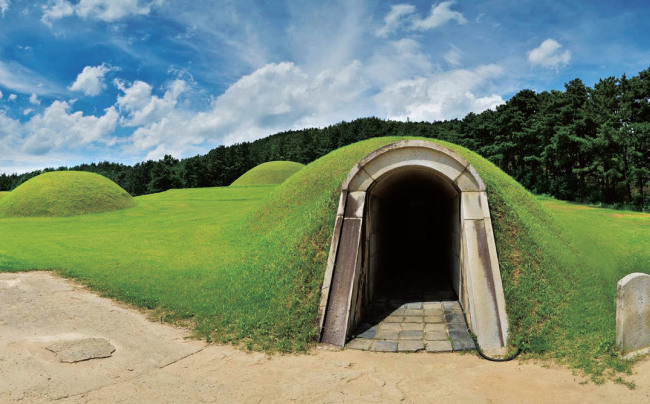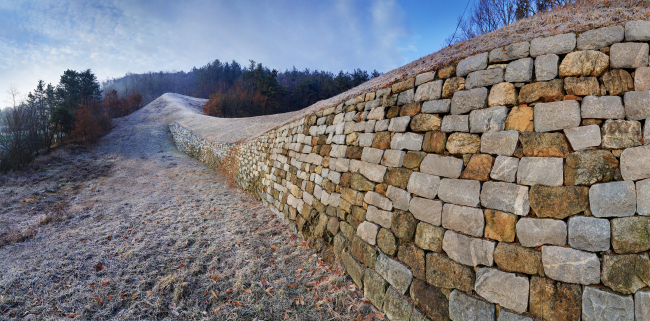Ancient Baekje historic areas named a UNESCO world heritage site
Sites belonging to the Baekje Kingdom show transmission of opulent culture from west to east
By 줄리 잭슨 (Julie Jackson)Published : July 5, 2015 - 17:43
Eight ancient Baekje historic areas were collectively named as a UNESCO World Heritage site Saturday, becoming Korea’s 12th item on the much-coveted World Heritage list.
It joins the ranks of the volcanic island of Jeju, Seoul’s Changdeokgung Palace and the mountain fortress of Namhansanseong.
The Baekje historic areas are a collection of sites built over the different periods of Baekje, spanning nearly 700 years from B.C. 18 to A.D. 660. The sites, including royal palaces and fortresses, tombs, temple sites and other archaeological sites, are scattered from Gongju and Buyeo in South Chungcheong Province to Iksan in North Jeolla Province.
It joins the ranks of the volcanic island of Jeju, Seoul’s Changdeokgung Palace and the mountain fortress of Namhansanseong.
The Baekje historic areas are a collection of sites built over the different periods of Baekje, spanning nearly 700 years from B.C. 18 to A.D. 660. The sites, including royal palaces and fortresses, tombs, temple sites and other archaeological sites, are scattered from Gongju and Buyeo in South Chungcheong Province to Iksan in North Jeolla Province.

“Together, these sites represent the later period of the Baekje Kingdom -- one of the three earliest kingdoms of the Korean peninsula -- during which time they were at the crossroads of considerable technological, religious (Buddhism), cultural and artistic exchanges between the ancient East Asian kingdoms in Korea, China and Japan,” according to a UNESCO press statement released Saturday.
Baekje not only played a critical role in the development of ancient culture in Korea, but also contributed to the overall cultural development of East Asia. It was an active cultural transmitter, adopting rich culture from China and passing it on to Japan and other neighboring states.
Much of the opulence and splendor shown in Baekje’s art and artifacts are due to the development of Buddhism, which was adopted from China. Buddhism spread to Japan later along with Baekje’s techniques and styles of making art and architecture.
“Baekje had extensive cultural exchanges with China, Japan and Southeast Asia across the sea. As a result, Baekje shaped an elegant, rich and outstanding culture with an international mind. Now we can share that value with people in the world as it is recognized globally,” said Na Sun-hwa, chief of the Cultural Heritage Administration, a state cultural heritage agency.

The inclusion of these sites in the world heritage list was highly anticipated by provincial governments in the old Baekje areas as well as its citizens because it is expected to benefit tourism.
The WHC recommended the Korean government to set up tourism management plans for the designated historic sites and monitor regularly for changes in the conditions of artifacts, according the CHA.
The Baekje historic areas were among 37 properties nominated on the UNESCO’s World Heritage list at the 39th session of the World Heritage Committee in Bonn, Germany on Saturday.
Other cultural site nominations included the Japanese Meiji Industrial Revolution sites, Chinese Tusi sites, Singapore’s Botanic Gardens and the Great Burkhan Khaldun Mountain and its surrounding sacred landscape in Mongolia.
Meanwhile, the 39th session of the WHC delayed the decision on Japan’s bid to include the Meiji-era industrial sites, as South Korea and Japan still remain at odds over the description of the Japanese sites in their statements.
Japan’s world heritage bid has drawn controversy as the industrial sites for iron and steelmaking, shipbuilding and coal mining that drove Japan’s industrialization are also linked to wartime slave labor, with a large number of Koreans forced to work at several of the sites during colonial times.
By Lee Woo-young (wylee@heraldcorp.com)


















![[Today’s K-pop] Treasure to publish magazine for debut anniversary](http://res.heraldm.com/phpwas/restmb_idxmake.php?idx=642&simg=/content/image/2024/07/26/20240726050551_0.jpg&u=)